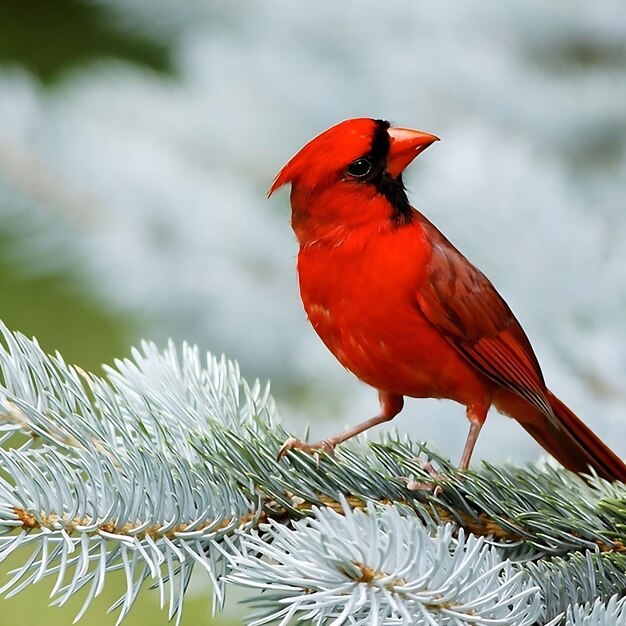Missouri, often known as the “Show-Me State,” boasts a rich history and diverse landscapes and is home to a vibrant avian population. Red birds are some of the most striking and captivating among the many birds that grace the state with their presence. In this article, we’ll delve into the fascinating world of red birds in Missouri, exploring their characteristics, habits, and the conservation efforts to protect them.
Table of Contents
ToggleNorthern Cardinal (Cardinalis cardinalis)
The Northern Cardinal, also known simply as the Cardinal, is one of Missouri’s most iconic red birds. Its striking red plumage and distinctive crest make it easily recognizable. Male cardinals are a brilliant red, while females sport a more subdued brownish-red coloration. These birds are a year-round presence in the state, and their sweet songs are a familiar sound in Missouri’s backyards.
Summer Tanager (Piranga rubra)
The Summer Tanager is another beautiful red bird that can be spotted in Missouri, particularly during the spring and summer months. They are slightly larger than cardinals and have a vibrant, all-over red plumage. Their diet primarily consists of insects and fruits, and their melodic songs add a pleasant ambiance to the Missouri woods.
Scarlet Tanager (Piranga olivacea)
While the Scarlet Tanager is not as common as the Northern Cardinal, its striking red plumage and black wings make it a sight. These birds are often found in wooded areas, and their high-pitched, robin-like songs echo through the trees during the breeding season.
Vermilion Flycatcher (Pyrocephalus rubinus)
The Vermilion Flycatcher, though less well-known than cardinals or tanagers, is a stunning red bird found in the southern parts of Missouri. These flycatchers are known for their agile hunting skills and dazzling scarlet plumage, especially in males. They feed on insects by catching them in mid-air.
Comparison of Red Birds in Missouri
To help you differentiate between these red birds, let’s summarize their key characteristics:
- Northern Cardinals are known for their bright red color and distinctive crest.
- Summer Tanagers are more extensive with an all-red appearance.
- Scarlet Tanagers have black wings and a high-pitched song.
- Vermilion Flycatchers are agile insect hunters with striking red plumage.
Habitat and Range
Redbirds in Missouri can be found in various habitats, from woodlands and forests to suburban backyards. Cardinals, for instance, adapt well to human-made environments, while tanagers are commonly spotted in deciduous forests.
Feeding Habits
These red birds have diverse diets. Cardinals primarily eat seeds, while tanagers and flycatchers prefer insects and fruits. Offering a variety of food sources can attract them to your yard.
Breeding and Nesting
Many red birds in Missouri build cup-shaped nests in trees or shrubs. Breeding seasons vary, and they often raise their chicks in well-concealed nests.
Conservation Status
Conservation efforts are crucial to protect these red birds and their habitats. While Northern Cardinals are not of immediate concern, Summer Tanagers and Scarlet Tanagers face threats due to habitat loss. Supporting conservation organizations is essential for their preservation.
Attracting Red Birds to Your Backyard
To attract red birds to your backyard, consider providing bird feeders with various seeds and fruits. Planting native trees and shrubs can create a welcoming habitat for these beautiful birds.
Interesting Facts about Red Birds
- Northern Cardinals are the official state bird of seven U.S. states.
- The brilliant red plumage of male cardinals is thought to symbolize life and fire, while the brownish color of females represents the earth.
- Summer Tanagers were once called “Tanager Cardinals” due to their vibrant red coloration.
The Importance of Conservation Efforts
Conserving the natural habitats of these red birds is crucial for their survival. By supporting organizations dedicated to preserving Missouri’s ecosystems, you can contribute to protecting these beautiful birds.
Conclusion
Red birds in Missouri enrich the state’s biodiversity with their stunning red plumage and melodic songs. While they face various challenges, their beauty and significance in the ecosystem make them worth preserving. By understanding these red birds and the importance of conservation, we can ensure their continued presence in the “Show-Me State.”
FAQs about Red Birds in Missouri
- Are all red birds in Missouri related to cardinals?
No, while cardinals are the most well-known red birds, other species like tanagers and flycatchers in Missouri have different characteristics.
- How can I attract red birds to my backyard?
You can attract red birds by offering a variety of food sources, including seeds and fruits, and creating a welcoming habitat with native trees and shrubs.
- What is the conservation status of these red birds?
Northern Cardinals are of minor concern, but Summer and Scarlet Tanagers face threats due to habitat loss. Supporting conservation efforts is crucial.
- Are red birds important to Missouri’s ecosystem?
Yes, red birds play a role in the ecosystem by helping control insect populations and contributing to the overall biodiversity of the state.
- Can I spot red birds year-round in Missouri?
Yes, Northern Cardinals are present year-round, while other red birds, like Summer Tanagers, are more commonly seen during the spring and summer months.





